 Yup, wealth and/or power gives birth to greed and pride, which is what happened to Satan.
Yup, wealth and/or power gives birth to greed and pride, which is what happened to Satan. 
I think that is what happened to some of our presidents too, but certainly not the Bushes, Clinton and Obama, they were wicked before they took office.
And of course we can’t forget about the Jews, the Jews that aren’t Yours.
There’s a big mess in Israel and Syria right now, so I might as well end this series of Lost Cities of the Near and Middle-East by looking at…
Ezekiel 37
Vision of the Dry Bones in the Valley

1 The hand of the LORD was upon me, and carried me out in the spirit of the LORD, and set me down in the midst of the valley which was full of bones,
38:1-28 – one of Ezekiel’s major visions. Surprisingly no date is given (as in 1:2, 8:1, 40:1), but the event must have occurred sometime after 586 B.C.
2 And caused me to pass by them round about: and, behold, there were very many in the open valley; and, lo, they were very dry.
3 And he said unto me, Son of man, can these bones live? And I answered, O Lord GOD, thou knowest.
This is not symbolic, but visual premonition.
4 Again he said unto me, Prophesy upon these bones, and say unto them, O ye dry bones, hear the word of the LORD.
5 Thus saith the Lord GOD unto these bones; Behold, I will cause breath to enter into you, and ye shall live:
6 And I will lay sinews upon you, and will bring up flesh upon you, and cover you with skin, and put breath in you, and ye shall live; and ye shall know that I am the LORD.
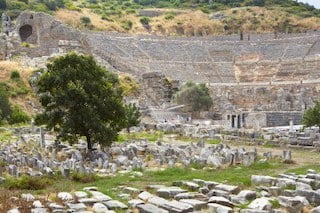
7 So I prophesied as I was commanded: and as I prophesied, there was a noise, and behold a shaking, and the bones came together, bone to his bone.
8 And when I beheld, lo, the sinews and the flesh came up upon them, and the skin covered them above: but there was no breath in them.
9 Then said he unto me, Prophesy unto the wind, prophesy, son of man, and say to the wind, Thus saith the Lord GOD; Come from the four winds, O breath, and breathe upon these slain, that they may live.
10 So I prophesied as he commanded me, and the breath came into them, and they lived, and stood up upon their feet, an exceeding great army.
11 Then he said unto me, Son of man, these bones are the whole house of Israel: behold, they say, Our bones are dried, and our hope is lost: we are cut off for our parts.
“Our bones…cut off” – a sense of utter despair, to which the vision offers hope.
12 Therefore prophesy and say unto them, Thus saith the Lord GOD; Behold, O my people, I will open your graves, and cause you to come up out of your graves, and bring you into the land of Israel.
“Graves” – the imagery shifts from a scattering of bones on a battlefield to a cemetery with sealed graves.
13 And ye shall know that I am the LORD, when I have opened your graves, O my people, and brought you up out of your graves,

14 And shall put my spirit in you, and ye shall live, and I shall place you in your own land: then shall ye know that I the LORD have spoken it, and performed it, saith the LORD.
“I shall place you in your own land” – these words make it clear that the Lord is not speaking here of a resurrection from the dead but of the national restoration of Israel.
15 The word of the LORD came again unto me, saying,
16 Moreover, thou son of man, take thee one stick, and write upon it, For Judah, and for the children of Israel his companions: then take another stick, and write upon it, For Joseph, the stick of Ephraim, and for all the house of Israel his companions:
17 And join them one to another into one stick; and they shall become one in thine hand.
18 And when the children of thy people shall speak unto thee, saying, Wilt thou not shew us what thou meanest by these?
“Wilt thou not shew us…? – the symbolic act successfully aroused the people’s curiosity.
19 Say unto them, Thus saith the Lord GOD; Behold, I will take the stick of Joseph, which is in the hand of Ephraim, and the tribes of Israel his fellows, and will put them with him, even with the stick of Judah, and make them one stick, and they shall be one in mine hand.
“They shall be one in mine hand” – God would duplicate Ezekiel’s symbolic act by uniting the two kingdoms separated since Solomon’s death. For similar prophecies of the reunion of Israel.
20 And the sticks whereon thou writest shall be in thine hand before their eyes.
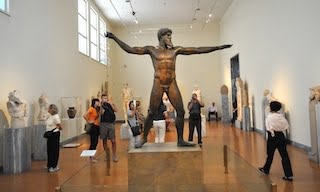
often called the God from the Sea) is an ancient Greek sculpture that was recovered from the sea off Cape Artemision, in northern Euboea (Modern Greek Εύβοια, Évia). It represents either Zeus[1] or Poseidon,[2] slightly over lifesize,[3] brandishing a missing thunderbolt (if Zeus) or trident (if Poseidon) with his raised right hand and sighting over his extended left hand.
The debate over whether the statue represents Poseidon or Zeus hinges on the lost attribute held in the right hand.
21 And say unto them, Thus saith the Lord GOD; Behold, I will take the children of Israel from among the heathen, whither they be gone, and will gather them on every side, and bring them into their own land:
22 And I will make them one nation in the land upon the mountains of Israel; and one king shall be king to them all: and they shall be no more two nations, neither shall they be divided into two kingdoms any more at all:
23 Neither shall they defile themselves any more with their idols, nor with their detestable things, nor with any of their transgressions: but I will save them out of all their dwelling places, wherein they have sinned, and will cleanse them: so shall they be my people, and I will be their God.
24 And David my servant shall be king over them; and they all shall have one shepherd: they shall also walk in my judgments, and observe my statutes, and do them.
“David my servant” – as in 34:23, the coming Messianic ruler is called David because He would be a descend ant of David and would achieve for Israel what David had, except more fully.
25 And they shall dwell in the land that I have given unto Jacob my servant, wherein your fathers have dwelt; and they shall dwell therein, even they, and their children, and their children’s children for ever: and my servant David shall be their prince forever.
26 Moreover I will make a covenant of peace with them; it shall be an everlasting covenant with them: and I will place them, and multiply them, and will set my sanctuary in the midst of them for evermore.
“Everlasting covenant” – the phrase occurs 16 times in the Old Testament, referring at times to the Noahic covenant (Gen 9:16), the Abrahamic covenant (Gen 17: 7, 13, 19), the Davidic (2 Sam 23:5) and the “new” (Jer 32:40).
27 My tabernacle also shall be with them: yea, I will be their God, and they shall be my people.
28 And the heathen shall know that I the LORD do sanctify Israel, when my sanctuary shall be in the midst of them for evermore.
Lost Cities of the Near and Middle-East:
Ephesus Location: Aegean Coast of Turkey
Location: Aegean Coast of Turkey
Date of Construction: 10th Century B.C.
Abandoned: c 15thCentury B.C.
Built By: Greek Colonists
Key Features: Artemision; Odeon; Library of Celsus; Great Theatre; Double Church of The Virgin and St John; Baths of Constantine; Statues of The Amazons
Each year tens of thousands of tourists tramp around a collection of dusty ruins many miles inland from the sea, gawping at cracked flagstone paving, the occasional row of low, crumbled shop fronts and the reconstructed facade of an ancient library, before reaching a marshy rectangular depression.

Eighteen hundred years ago a visitor would have been greeted with a very different prospect, for this was Ephesus, the greatest city in Asia Minor, the richest port in the Roman Empire and the site of the Temple of Artemis, a cult site of extreme antiquity and one of the Seven Wonders of the Ancient World.
The visitor’s eye would have delighted at the:
Great mass of public buildings in white marble,
The busy docks, lapped by the waters of the Aegean and thronged with the trade of many nations,
The mule trains and wagons carrying goods and people back and forth from the Anatolian hinterland,
The barges and river boats on the River Cayster,
The lush, fertile farmland on the plain all about, and above all,
The colossal temple with its crowds of priests, astrologers, mountebanks, disputatious Christians, entertainers, hawkers, craftsmen and pilgrims, hailing from distant lands from Persia to Britain.
City of the Amazons
The city had been founded by Athenian and Ionian Greek colonists in around the 10th century B.C. on the site of an older Hittite settlement called Apasa.
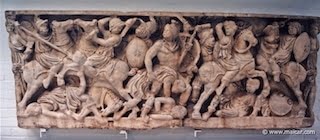
Low hills surrounded by fertile though marshy plains commanded the course of the River Cayster or Kaystros (Kuquk Menderes in modern-day Turkish) where it flowed into the Aegean, and here the Greeks built their city, subsuming a pre-existing cult site sacred to the local goddess Cybele, whom the newcomers associated with Artemis, and who would later incorporate many aspects of fertility and virgin-huntress goddesses from all over the ancient world.
Later the Greeks claimed mythical origins for the city, attributing its founding to the Amazons, and after them to the 11th century B.C. Athenian prince, Androclus.
The colony prospered, producing some of the first coins ever minted, c. 700 B.C., but in the 7th century B.C. was sacked by rampaging Cimmerians who burned down the Artemision (Temple of Artemis).
Later it fell into Lydian hands when it was besieged by Croesus. He used his legendary wealth to help rebuild the Artemision.
When Cyrus of Persia conquered Lydia in 547 B.C., Ephesus fell under Persian dominion, but the Persian emperors, out of respect for the temple, left it unmolested.
In 334 B.C. the city welcomed Alexander the Great, who reestablished its democratic government, and it then passed into the control of his general Lysimachus, who relocated many of the inhabitants from the low-lying marshy plains to the hills and enclosed the city with a defensive wall.
Roman and Byzantine Ephesus
Lysimachus was defeated by the Seleucids, but they in turn gave way to the Romans who handed the city over to Pergamum , although in 133 B.C. it returned to Roman control. Under the Romans Ephesus vied with Pergamum for the status of chief city of Asia, eventually becoming the capital of the province of Asia, while its mercantile activities made it for a while the richest port in the empire.

Roman control of Ephesus continued unbroken except for the uprising of Mithridates VI of Pontus in 88 B.C. Corrupt Roman tax farmers and speculators had aroused the ire of the Asians and Mithridates incited the Asian cities to rise up against their Roman overlords and massacre every Latin in Asia.
Even those who tried to claim sanctuary at the Artemision (see below) were slaughtered. Estimates of the death toll range from 80-150,000. When the Roman general Sulla defeated Mithridates and crushed the uprising, Ephesus escaped with a heavy fine.
From the 1st century B.C. Ephesus flourished, growing to around 225,000 inhabitants (some authority’s claim it was much larger, with up to 500,000 inhabitants, which would probably have made it the largest city in the world at the time).
Many impressive buildings were constructed and the city was provided with some of the most extensive aqueducts and other hydrological infrastructure of the ancient world.
The Artemision, too, continued to flourish, although it became a major focus of discontent for the growing Christian community, including St Paul, who famously triggered a riot when his preaching angered idol-makers at the temple, prompting them to gather a huge mob at the city’s gigantic theater (site of contests between gladiators, some of whom were buried at a recently discovered graveyard in the city).
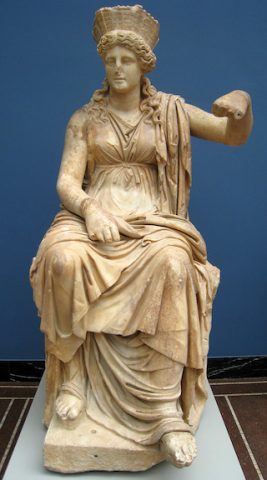
Ephesus was to become one of the most important dioceses of the nascent Church, with cult sites such as the tomb of St John the Apostle and the last resting place of the Virgin Mary. Major church councils were held there, but eventually it lost influence and power to Constantinople.
Under the Byzantines the city declined, its population reduced by malaria from the surrounding marshes and its fabric degraded by a series of assaults and sackings:
By the Arabs in 655 and 717,
The Iconoclasts in the 8th and 9th centuries,
The Seljuk Turks in 1090 and the early 14th century,
Catalonian mercenaries in the pay of Byzantium, then the Turks again,
Tamerlane in 1403 and
A series of feuding emirs throughout the rest of the 15th century.
In 1439 Mark of Ephesus visited Florence for a council bringing together the Eastern and Western Churches, and although he treated the Latins with great disdain and haughtiness, he was, in the words of the Catholic Encyclopedia, merely “the pastor of a miserable village.” By this time the city’s ancient harbor had long-since silted up and it now lays some 3 miles inland.
Main Buildings of Ephesus
Excavations by mainly British and Austrian archaeologists have revealed some of the splendor of ancient Ephesus. Paved streets (some paved with marble, others with mosaics) and colonnades lead to some impressive surviving or rebuilt structures.

The Odeon was a roofed theatre used for musical performances, poetry readings and prize-giving; it had seating for 2,200 people. Next to it was the agora or public square, with large halls, columns, porticoes and shops.
Curetes Street runs west from here to the town Centre, close to which is the most impressive extant facade in Ephesus – the Library of Celsus. Built to honor the recently deceased proconsul of Asia, T. Julius Celsus, whose tomb lies nearby, this library held 12,000 scrolls. Cunning architecture, involving a convex lower tier, makes the facade seem bigger than it really is.
From the Centre of town the Sacred Way, also known as the Marble Street, leads to the Great Theatre, which has seating for 25,000.
A broad road known as Arcadiane ran from here to the port, passing on the right the great Baths of Constantine, so large that visitors would sometimes mistake them for the Artemision. In the northwest of the ancient city lay the Double Church of the Virgin and St John, where the early church councils were held.
The Artemision
The ancient Greek writer Antipater of Thessalonica wrote that although he had seen the Hanging Gardens of Babylon, the Colossus of Rhodes, the Mausoleum and the Pyramids, none compared to the glories of the Artemision,
“when I saw the house of Artemis that mounted to the clouds, those other marvels lost their brilliancy, and I said, ‘Lo, apart from Olympus, the Sun never looked on aught so grand.’”
The colossal temple, situated a little way off from the main city, was rebuilt several times. It was relatively small (originally just an altar on a platform of green schist) until Croesus paid for a huge Ionic temple, built entirely of marble and incorporating 127 columns.
This incarnation of the temple was 380½ feet long and 180½ feet wide, covering an area of about 79,975 square feet. According to Pliny it was built on marshy ground to help protect it from earthquakes and took 120 years to complete, finally being consecrated sometime between 430 and 420 B.C.
Among the many treasures with which it was endowed were a series of bronze statues of Amazons created for a competition by the leading sculptors of the day, including Phidias who made the famous chryselephantine statues of Zeus and Athena Parthenon.
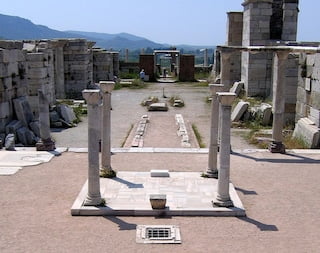
The basilica is on the slopes of Ayasoluk Hill just below the fortress near the center of Selçuk, İzmir Province, Turkey and about 3.5 km (2.2 mi) from Ephesu
According to the ancient scribes, this version of the temple was destroyed in 356 B.C. (on the same night as the birth of Alexander the Great), when a man named Herostratus set fire to the wooden frame of the roof, hoping to win eternal renown (or at least infamy) for his evil deed.
It was soon rebuilt, this time with columns 18 59 feet high and continued to attract crowds of pilgrims, priests and hangers-on, generating considerable industry and income for the city.
A coin from the reign of Claudius (c. 50 C.E.) shows the temple pediment with three windows or openings, which were probably used to display either the famous bronze Amazons or images of the goddess herself.
But the version of Artemis worshipped at Ephesus was very different from those of Athens or the Roman Diana.
The Ephesian Artemis-Cybele combined prehistoric traditions with Persian and other influences, to produce a complex iconography featuring a woman with many breasts (that may actually have symbolized eggs, bees or the testicles of sacrificial bulls) and other symbols of fecundity and natural bounty.
An important feature of the temple was the right to asylum that applied within its sacred bounds, which meant that criminals, fugitives and those in fear of their lives could not be harmed or arrested once they passed within its precincts.

Under Mark Anthony the boundaries of asylum were extended to include parts of the city proper, which resulted in that quarter degenerating into a den of vice. The inviolate nature of the sacred precincts also made the Artemision a safe place to store money, and great quantities of treasure were banked here for safekeeping.
Although it was sacked and burned by the Goths in 262 C.E., it was at least partially restored and continued to be a major religious Centre until the Edict of Theodosius forced the closing of the pagan temples, and its stones were quarried for the construction of a nearby cathedral.
Some were even burnt for lime. By the time of the Ottoman conquest the site was buried under 3% feet of silt, and today a single forlorn pillar marks the spot where this ancient wonder once stood.
…Palmyra.
Visits: 0
